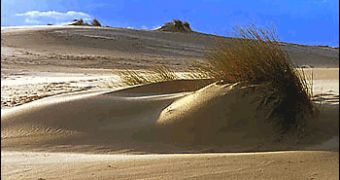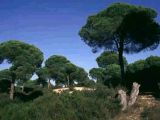Do?ana National Park is located in southwestern Spain, at the mouth of the Guadalquivir River. It was created in 1969, initially having a surface of 37,000 hectares. In 1978, the park was augmented to 50,720 hectares, to which 26,540 hectares of protected areas, located at its periphery, are added.
The park is in a continuous change, being influenced by both Mediterranean and oceanic clime. The winters are rainy and the summers, long and dry. Usually, there is no rain from the middle of June to the fall. Do?ana has three great ecosystems: beaches with sand dunes, swamps and matorral (Mediterranean veld).
The beaches have white, fine sand raised by the wind towards the interior, forming high dunes. The beach life depends on the tide rhythm and the southwestern winds. The dune system of Do?ana is unique in Spain. Between two dunes, there may be thickets and pine patches. After being covered by sand, the seeds of these plants will germinate, forming new forests.
Corpses of sea animals gather on the beaches, from crustaceans, mollusks and fish, to cetaceans and even sea turtles. This is the habitat for many terns, gulls, plovers, dunlins, godwits. In the winter, there are rare visitors, represented by cormorants and puffins. Barn owls, ravens and peregrine falcons make their nests in the beach towers, built during the 16th centuries.
The matorral represents the most stable ecosystem of Do?ana, with the highest biomass. Even if matorral comes from Spanish "mata" (bush), many tree species are found here: wild olives, cork oaks and eucalyptuses (which are exotic, brought from Australia). The bushes are represented by rosemaries, lavenders and thymes and offer shelter and refuge for many species.
The matorral harbors 80 species of vertebrates, half of them birds. When the night falls, mammals of the matorral go out for foraging: red foxes, Iberian lynxes (an endangered species), wild boars, mongooses (one of the few places in Europe where these mammals are found), genets or badgers. The most common reptiles are vipers, grass snakes and tortoises. The most abundant birds are the partridges, bush-warblers, wood pigeon, green woodpeckers and nightjars. The most common amphibians of the matorral are the tree frogs and common toads. Prey birds dwelling here are the Spanish Imperial eagle (the park harbors one of the few populations of the species), red kite and common buzzard.
The edge of the swamps form a fringe 200-1,500 m (660-5,000 ft) wide, called "vera", where excellent fodder grasses grow. The herbivorous fauna of the vera is made of rabbits, roe deer, red deer, fallow deer and wild boars. There are also many insectivorous birds in the area: lapwings, moorhens, bee eaters and grasshopper-warblers.
The cork oaks of the Do?ana may harbor spectacular colonies of water birds: on the top, storks and spoonbills nest, while egrets, night herons and squacco herons nest on the lower levels of the trees.
The swamp, La Marisma, represents the youngest ecosystem of the area, the result of depositing of the sand and mud transported by the waters. The aspect changes significantly, depending on the season. The winter rains turn La Marisma into a shallow lagoon, as its clay soils impede the drainage of the waters. This lagoon is the wintering place for many water birds that nest in the north of Europe. In the spring, the swamp looks like a green plain with a lush vegetation, a perfect nesting place for many birds. To the end of May, the swamp starts to dry and heat of the summer evaporates totally its water, until July leaving a desert landscape, a plain of cracked clay wandered by roe deer, reed deer and wild boars. The water starts collecting again in October.
In some points of the swamp, there are deep pools that do not dry up during the summer, los lucios, which act like oases for water birds. There are also high areas of the swamp that are never flooded. The swamps of Do?ana are considered to be the most important wetland both in the Western Europe and Northern Africa. The park was declared Biosphere Reserve by UNESCO.
The best touristic areas of Do?ana are represented by El Achebuche and La Rocina. The human history of the place is presented in the museum "Palacio del Acebron". The human population of Do?ana is represented by land owners, guardians and workers. The land owners visit the place several times per year for relaxing. In other times, they brought their friends for hunting parties. The most important hunted animals were deer, wild boars, rabbits and various bird species. The main tourist settlement of Do?ana is Matalascanas.

 14 DAY TRIAL //
14 DAY TRIAL // 
